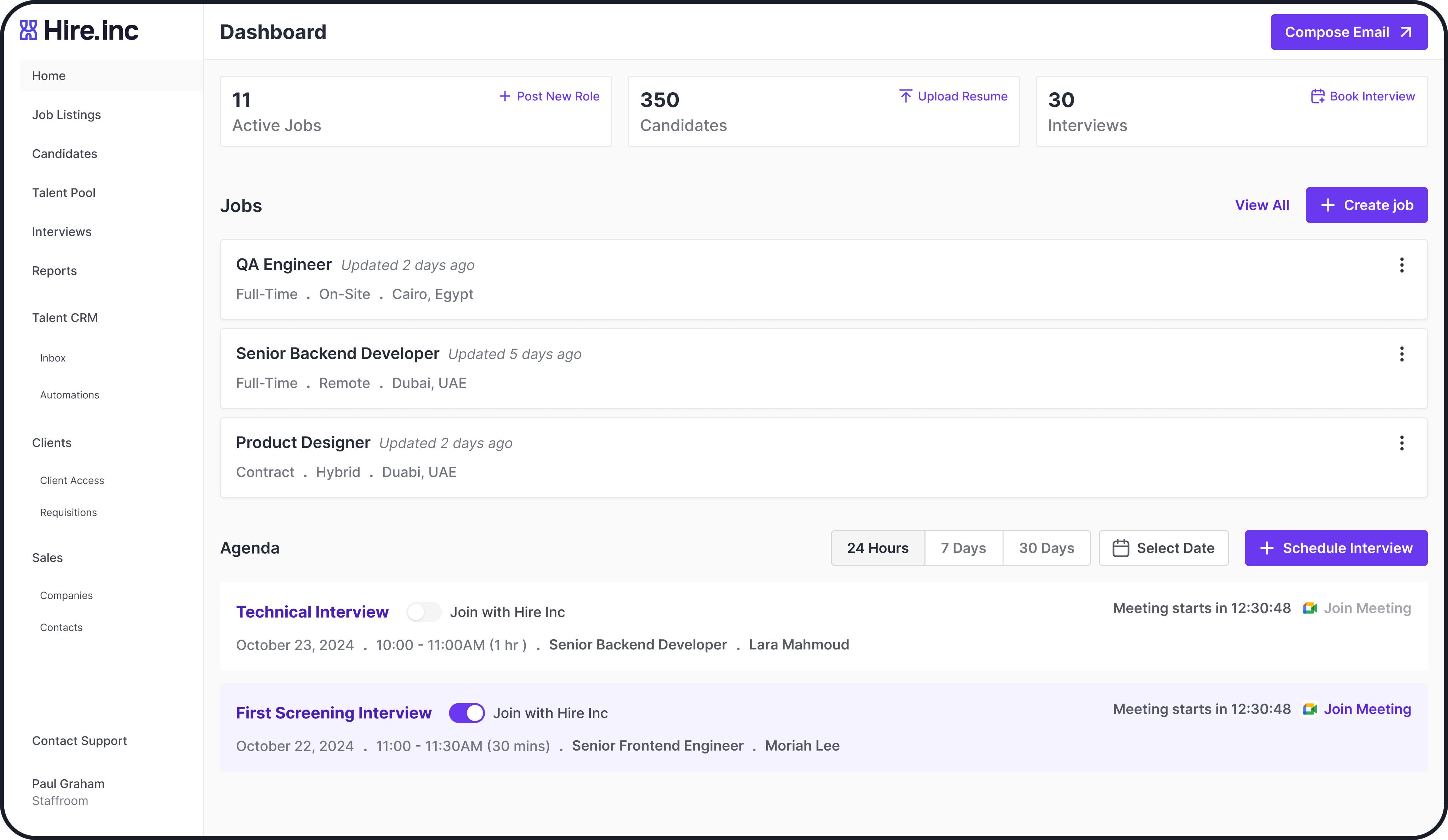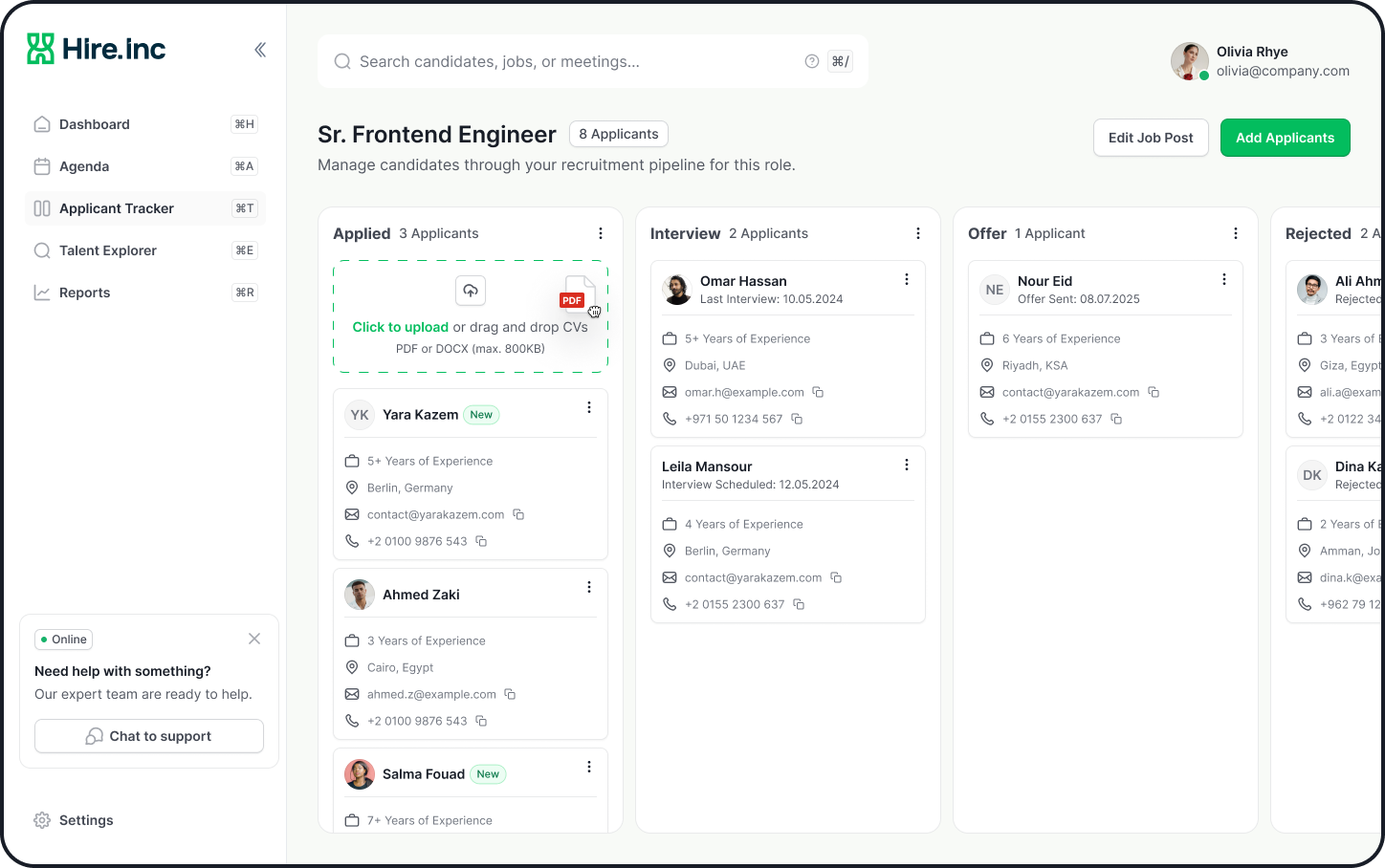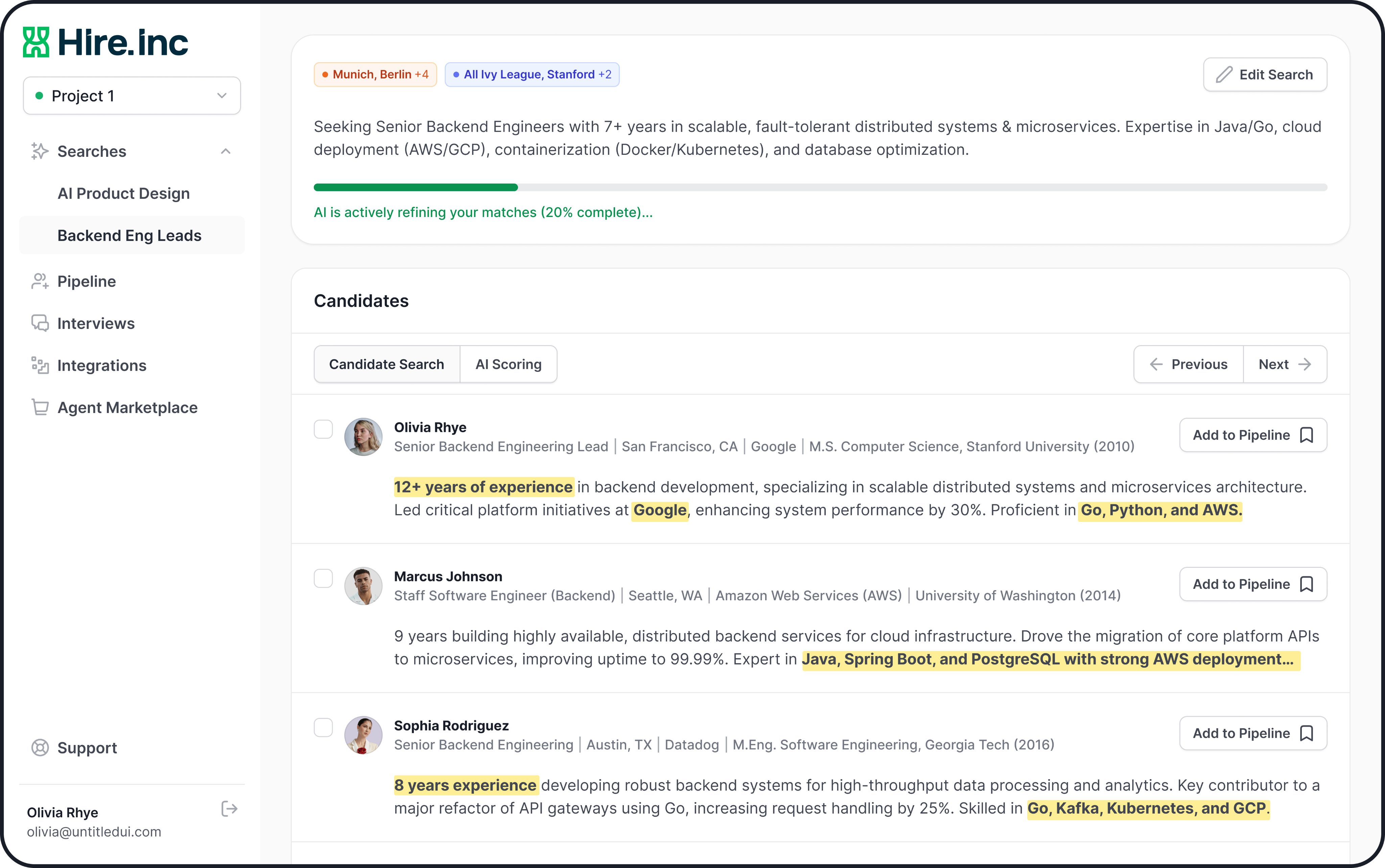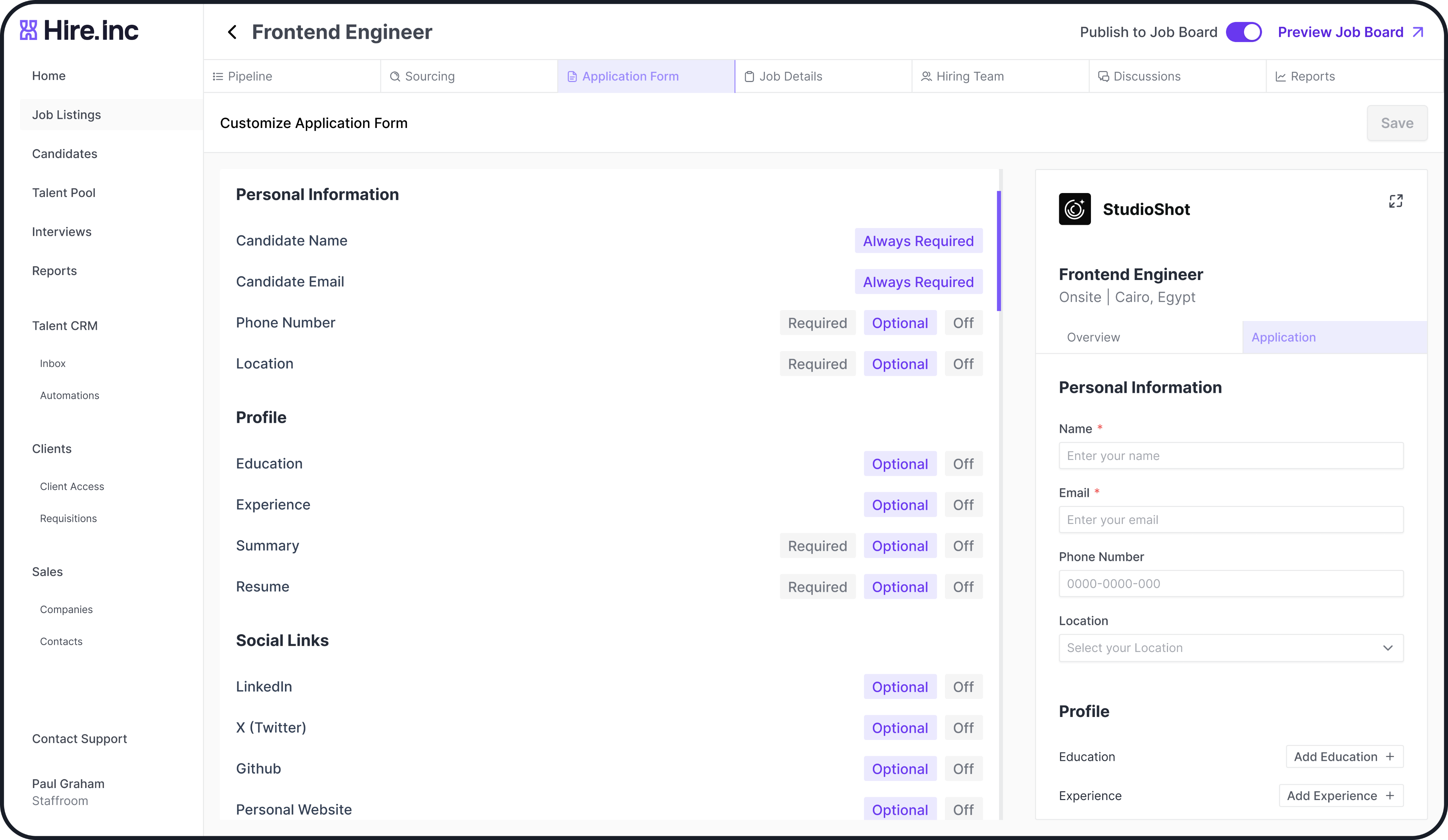Revolutionizing Recruitment with Hire Inc’s AI-Powered Platform
The platform empowering recruiters build and scale their business with streamlined sourcing, interviews, business development and collaborative hiring.

The Challenge
Recruiters today juggle fragmented tools across sourcing, interview scheduling, feedback collection, and collaboration. These disjointed workflows lead to inefficiencies, miscommunication, and slow hiring cycles, especially in fast-paced tech companies.
Our Goal
Design a seamless, intelligent recruiting platform that empowers recruiters to move faster, make better decisions, and collaborate effortlessly, with AI as their co-pilot.
My Role
As the sole Product Designer on the Hire.inc team, my role extended beyond typical UX/UI responsibilities, embodying a comprehensive hybrid approach. I was deeply involved in bridging product strategy, in-depth user research, and core product thinking, acting as a pivotal link between user needs and technical feasibility.
My responsibilities encompassed the entire design lifecycle, from initial concept generation and comprehensive user research to wireframing, prototyping, high-fidelity UI design, and continuous iterative testing. A key aspect of my contribution was fostering a highly adaptive, iterative, and research-driven process, ensuring every design decision was informed by continuous feedback loops from our target users – recruiters and hiring managers. I collaborated closely with product management and engineering teams to translate complex requirements into intuitive and effective user experiences, ensuring a cohesive and impactful product launch.
User Research & Discovery
Led interviews, surveys, and journey mapping sessions with recruiters
UX Strategy & Product Vision
Developed user personas, architecture, and user flows
Wireframing & Prototyping
Created low-to-high fidelity prototypes based on user feedback
Collaboration with Product & Engineering
Worked in agile sprints to refine features in real-time
Design Philosophy
A Research-Driven, Iterative Approach
Designing Hire.inc, a sophisticated AI-powered platform in the recruitment space, necessitated a design philosophy rooted deeply in research and continuous iteration. Unlike traditional linear design processes, this project demanded an agile and adaptive methodology. Our belief was that truly impactful solutions for complex user workflows could only emerge from:
Deep User Empathy
Continuously understanding the nuanced challenges faced by recruiters and hiring managers.
Validated Hypotheses
Testing assumptions early and often with real users to ensure solutions truly addressed pain points.
Continuous Improvement
Embracing feedback loops to refine features and interactions iteratively, ensuring the product evolved with user needs and technological advancements.
Understanding the Users

Lana Brooks
Senior Tech Recruiter
Lana Brooks is a senior tech recruiter at a mid-sized technology company, responsible for hiring engineering, product, and design talent. She is experienced but finds her workflow frustratingly slow, juggling multiple tools that don’t integrate well.
Company Size
Mid-sized tech company (500-1,000 employees)
Industry Focus
Hiring for Engineering, Product, and Design roles
Pain Points and Challenges
Inefficient candidate search
Current ATS search tools require manual filtering, making it time-consuming.
Disorganized feedback collection
Hiring managers provide input via Slack and email, causing delays.
Redundant administrative tasks
Manually tracking candidates and consolidating interview notes takes too much time.
Slow hiring decisions
Lack of real-time collaboration slows down hiring cycles.
How Hire Inc Transformed Lana’s Workflow
- AI-powered search streamlined candidate sourcing, reducing manual effort.
- AI-generated job descriptions eliminated repetitive drafting, freeing up time for strategic work.
- Shared candidate workspaces improves collaboration with hiring managers.
- Real-time feedback collection accelerated hiring decisions.
Research & Discovery
User Interviews
Conducted in-depth interviews with recruiters to identify pain points in the existing workflow
Competitive analysis
Evaluated existing ATS platforms (e.g., Greenhouse, Lever) to benchmark and identify differentiation opportunities
Journey Mapping
Created detailed maps of the recruiter workflow to identify friction points
Iteration 1
Traditional ATS Approach
Our initial concept followed conventional ATS patterns with:
Standard Job Posting Workflows
The initial flow mimicked typical ATS platforms, recruiters manually created job posts by filling in structured fields, but found the process repetitive and disconnected from candidate search.
Linear candidate tracking pipeline
Recruiters tracked candidates through fixed stages, but lacked flexibility in moving or tagging candidates, limiting adaptability to real-world workflows.
Basic Interview Scheduling
The prototype featured simple calendar integration, but didn’t account for multi-party scheduling or timezone conflicts, causing friction during coordination.



We’ve just launched a new feature!
Check out the new dashboard.
Iteration 2
AI as an Assistant
Redesigned with search as the core experience:
AI-Powered Candidate Search
Introduced natural language search that returned ranked, context-aware candidate profiles, reducing manual filtering time by over 40%.
Advanced skill-based filtering
Users could now filter by nuanced criteria like years of experience in specific tech stacks, previous company size, or role overlap; enabling more precise targeting.
One-click shortlisting
With AI-curated suggestions, recruiters could add candidates to the shortlist instantly, streamlining decision-making with clear visual indicators of fit.




Pivot 2
Enhancing AI Transparency & User control
Iteration 3
Enhanced Collaboration
Added transparecy to Ai and improved collaboration:
AI Transparency
Added visual cues to explain why a candidate was surfaced, giving recruiters more trust in AI recommendations.
Shared workspaces for teams
Recruiters and hiring managers could co-review candidates, leave inline notes, and align faster on next steps.
Slack-like discussion panel
Integrated real-time chat in the platform, reducing the need to coordinate feedback across tools like Slack or email.


Revolutionizing Recruitment with Hire Inc’s AI-Powered Platform
The platform empowering recruiters build and scale their business with streamlined sourcing, interviews, business development and collaborative hiring.

The Challenge
Recruiters today juggle fragmented tools across sourcing, interview scheduling, feedback collection, and collaboration. These disjointed workflows lead to inefficiencies, miscommunication, and slow hiring cycles, especially in fast-paced tech companies.
Our Goal
Design a seamless, intelligent recruiting platform that empowers recruiters to move faster, make better decisions, and collaborate effortlessly, with AI as their co-pilot.
My Role
As the sole Product Designer on the Hire.inc team, my role extended beyond typical UX/UI responsibilities, embodying a comprehensive hybrid approach. I was deeply involved in bridging product strategy, in-depth user research, and core product thinking, acting as a pivotal link between user needs and technical feasibility.
My responsibilities encompassed the entire design lifecycle, from initial concept generation and comprehensive user research to wireframing, prototyping, high-fidelity UI design, and continuous iterative testing. A key aspect of my contribution was fostering a highly adaptive, iterative, and research-driven process, ensuring every design decision was informed by continuous feedback loops from our target users – recruiters and hiring managers. I collaborated closely with product management and engineering teams to translate complex requirements into intuitive and effective user experiences, ensuring a cohesive and impactful product launch.
User Research & Discovery
Led interviews, surveys, and journey mapping sessions with recruiters
UX Strategy & Product Vision
Developed user personas, architecture, and user flows
Wireframing & Prototyping
Created low-to-high fidelity prototypes based on user feedback
Collaboration with Product & Engineering
Worked in agile sprints to refine features in real-time
Design Philosophy
A Research-Driven, Iterative Approach
Designing Hire.inc, a sophisticated AI-powered platform in the recruitment space, necessitated a design philosophy rooted deeply in research and continuous iteration. Unlike traditional linear design processes, this project demanded an agile and adaptive methodology. Our belief was that truly impactful solutions for complex user workflows could only emerge from:
Deep User Empathy
Continuously understanding the nuanced challenges faced by recruiters and hiring managers.
Validated Hypotheses
Testing assumptions early and often with real users to ensure solutions truly addressed pain points.
Continuous Improvement
Embracing feedback loops to refine features and interactions iteratively, ensuring the product evolved with user needs and technological advancements.
Understanding the Users

Lana Brooks
Senior Tech Recruiter
Lana Brooks is a senior tech recruiter at a mid-sized technology company, responsible for hiring engineering, product, and design talent. She is experienced but finds her workflow frustratingly slow, juggling multiple tools that don’t integrate well.
Company Size
Mid-sized tech company (500-1,000 employees)
Industry Focus
Hiring for Engineering, Product, and Design roles
Pain Points and Challenges
Inefficient candidate search
Current ATS search tools require manual filtering, making it time-consuming.
Disorganized feedback collection
Hiring managers provide input via Slack and email, causing delays.
Redundant administrative tasks
Manually tracking candidates and consolidating interview notes takes too much time.
Slow hiring decisions
Lack of real-time collaboration slows down hiring cycles.
How Hire Inc Transformed Lana’s Workflow
- AI-powered search streamlined candidate sourcing, reducing manual effort.
- AI-generated job descriptions eliminated repetitive drafting, freeing up time for strategic work.
- Shared candidate workspaces improves collaboration with hiring managers.
- Real-time feedback collection accelerated hiring decisions.
Research & Discovery
User Interviews
Conducted in-depth interviews with recruiters to identify pain points in the existing workflow
Competitive analysis
Evaluated existing ATS platforms (e.g., Greenhouse, Lever) to benchmark and identify differentiation opportunities
Journey Mapping
Created detailed maps of the recruiter workflow to identify friction points
Iteration 1
Traditional ATS Approach
Our initial concept followed conventional ATS patterns with:
Standard Job Posting Workflows
The initial flow mimicked typical ATS platforms, recruiters manually created job posts by filling in structured fields, but found the process repetitive and disconnected from candidate search.
Linear candidate tracking pipeline
Recruiters tracked candidates through fixed stages, but lacked flexibility in moving or tagging candidates, limiting adaptability to real-world workflows.
Basic Interview Scheduling
The prototype featured simple calendar integration, but didn’t account for multi-party scheduling or timezone conflicts, causing friction during coordination.



Pivot 1
Making search the core experience!
Iteration 2
AI as an Assistant
Redesigned with search as the core experience:
AI-Powered Candidate Search
Introduced natural language search that returned ranked, context-aware candidate profiles, reducing manual filtering time by over 40%.
Advanced skill-based filtering
Users could now filter by nuanced criteria like years of experience in specific tech stacks, previous company size, or role overlap; enabling more precise targeting.
One-click shortlisting
With AI-curated suggestions, recruiters could add candidates to the shortlist instantly, streamlining decision-making with clear visual indicators of fit.




Pivot 2
Enhancing AI Transparency & User control
Iteration 3
Enhanced Collaboration
Added transparecy to Ai and improved collaboration:
AI Transparency
Added visual cues to explain why a candidate was surfaced, giving recruiters more trust in AI recommendations.
Shared workspaces for teams
Recruiters and hiring managers could co-review candidates, leave inline notes, and align faster on next steps.
Slack-like discussion panel
Integrated real-time chat in the platform, reducing the need to coordinate feedback across tools like Slack or email.


Revolutionizing Recruitment with Hire Inc’s AI-Powered Platform
The platform empowering recruiters build and scale their business with streamlined sourcing, interviews, business development and collaborative hiring.

The Challenge
Recruiters today juggle fragmented tools across sourcing, interview scheduling, feedback collection, and collaboration. These disjointed workflows lead to inefficiencies, miscommunication, and slow hiring cycles, especially in fast-paced tech companies.
Our Goal
Design a seamless, intelligent recruiting platform that empowers recruiters to move faster, make better decisions, and collaborate effortlessly, with AI as their co-pilot.
My Role
As the sole Product Designer on the Hire.inc team, my role extended beyond typical UX/UI responsibilities, embodying a comprehensive hybrid approach. I was deeply involved in bridging product strategy, in-depth user research, and core product thinking, acting as a pivotal link between user needs and technical feasibility.
My responsibilities encompassed the entire design lifecycle, from initial concept generation and comprehensive user research to wireframing, prototyping, high-fidelity UI design, and continuous iterative testing. A key aspect of my contribution was fostering a highly adaptive, iterative, and research-driven process, ensuring every design decision was informed by continuous feedback loops from our target users – recruiters and hiring managers. I collaborated closely with product management and engineering teams to translate complex requirements into intuitive and effective user experiences, ensuring a cohesive and impactful product launch.
User Research & Discovery
Led interviews, surveys, and journey mapping sessions with recruiters
UX Strategy & Product Vision
Developed user personas, architecture, and user flows
Wireframing & Prototyping
Created low-to-high fidelity prototypes based on user feedback
Collaboration with Product & Engineering
Worked in agile sprints to refine features in real-time
Design Philosophy
A Research-Driven, Iterative Approach
Designing Hire.inc, a sophisticated AI-powered platform in the recruitment space, necessitated a design philosophy rooted deeply in research and continuous iteration. Unlike traditional linear design processes, this project demanded an agile and adaptive methodology. Our belief was that truly impactful solutions for complex user workflows could only emerge from:
Deep User Empathy
Continuously understanding the nuanced challenges faced by recruiters and hiring managers.
Validated Hypotheses
Testing assumptions early and often with real users to ensure solutions truly addressed pain points.
Continuous Improvement
Embracing feedback loops to refine features and interactions iteratively, ensuring the product evolved with user needs and technological advancements.
Understanding the Users

Lana Brooks
Senior Tech Recruiter
Lana Brooks is a senior tech recruiter at a mid-sized technology company, responsible for hiring engineering, product, and design talent. She is experienced but finds her workflow frustratingly slow, juggling multiple tools that don’t integrate well.
Company Size
Mid-sized tech company (500-1,000 employees)
Industry Focus
Hiring for Engineering, Product, and Design roles
Pain Points and Challenges
Inefficient candidate search
Current ATS search tools require manual filtering, making it time-consuming.
Disorganized feedback collection
Hiring managers provide input via Slack and email, causing delays.
Redundant administrative tasks
Manually tracking candidates and consolidating interview notes takes too much time.
Slow hiring decisions
Lack of real-time collaboration slows down hiring cycles.
How Hire Inc Transformed Lana’s Workflow
- AI-powered search streamlined candidate sourcing, reducing manual effort.
- AI-generated job descriptions eliminated repetitive drafting, freeing up time for strategic work.
- Shared candidate workspaces improves collaboration with hiring managers.
- Real-time feedback collection accelerated hiring decisions.
Research & Discovery
User Interviews
Conducted in-depth interviews with recruiters to identify pain points in the existing workflow
Competitive analysis
Evaluated existing ATS platforms (e.g., Greenhouse, Lever) to benchmark and identify differentiation opportunities
Journey Mapping
Created detailed maps of the recruiter workflow to identify friction points
Iteration 1
Traditional ATS Approach
Our initial concept followed conventional ATS patterns with:
Standard Job Posting Workflows
The initial flow mimicked typical ATS platforms, recruiters manually created job posts by filling in structured fields, but found the process repetitive and disconnected from candidate search.
Linear candidate tracking pipeline
Recruiters tracked candidates through fixed stages, but lacked flexibility in moving or tagging candidates, limiting adaptability to real-world workflows.
Basic Interview Scheduling
The prototype featured simple calendar integration, but didn’t account for multi-party scheduling or timezone conflicts, causing friction during coordination.



Pivot 1
Making search the core experience!
Iteration 2
AI as an Assistant
Redesigned with search as the core experience:
AI-Powered Candidate Search
Introduced natural language search that returned ranked, context-aware candidate profiles, reducing manual filtering time by over 40%.
Advanced skill-based filtering
Users could now filter by nuanced criteria like years of experience in specific tech stacks, previous company size, or role overlap; enabling more precise targeting.
One-click shortlisting
With AI-curated suggestions, recruiters could add candidates to the shortlist instantly, streamlining decision-making with clear visual indicators of fit.




Pivot 2
Enhancing AI Transparency & User control
Iteration 3
Enhanced Collaboration
Added transparency to AI and improved collaboration:
AI Transparency
Added visual cues to explain why a candidate was surfaced, giving recruiters more trust in AI recommendations.
Shared workspaces for teams
Recruiters and hiring managers could co-review candidates, leave inline notes, and align faster on next steps.
Slack-like discussion panel
Integrated real-time chat in the platform, reducing the need to coordinate feedback across tools like Slack or email.

